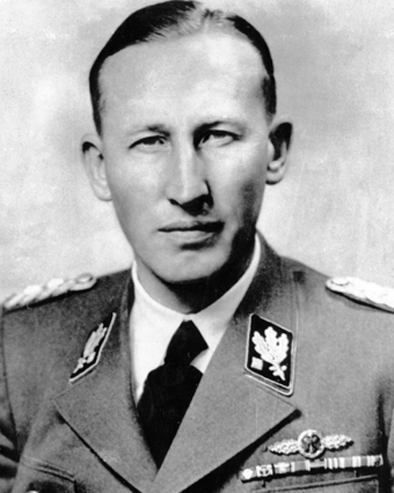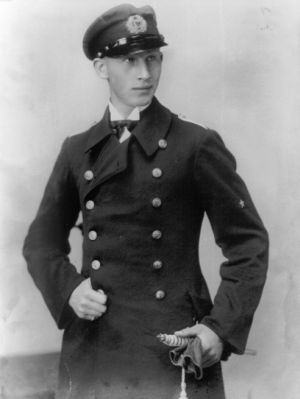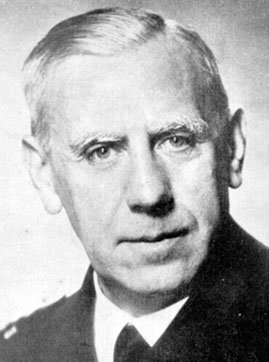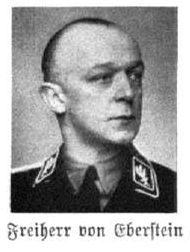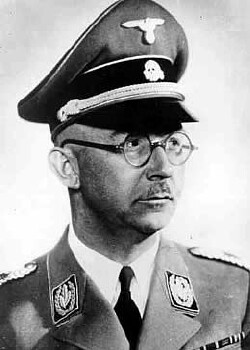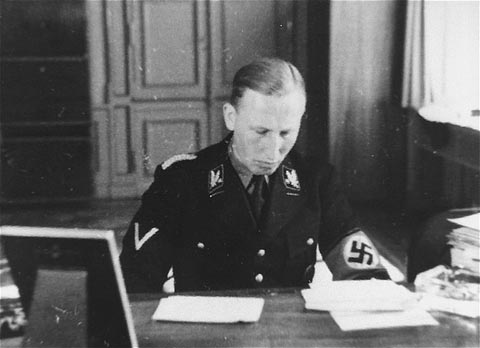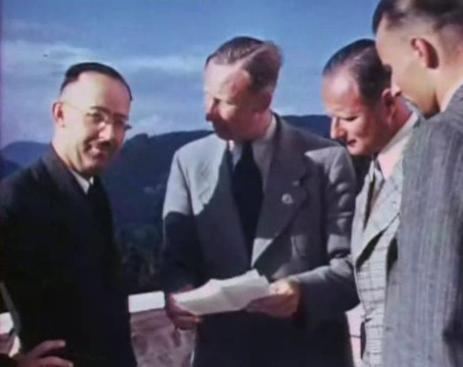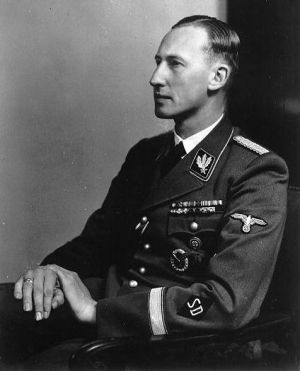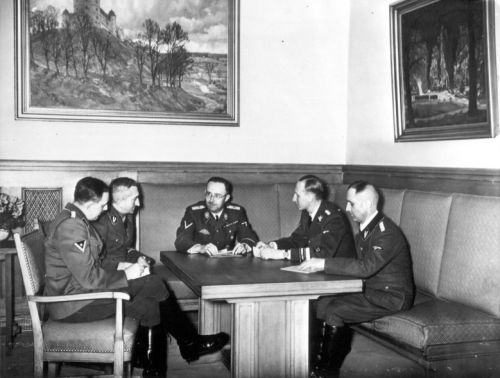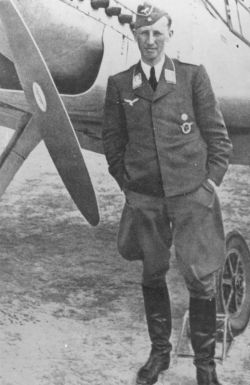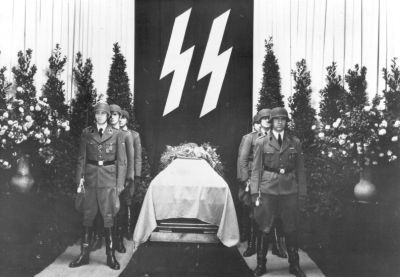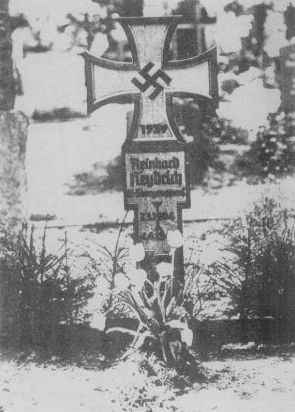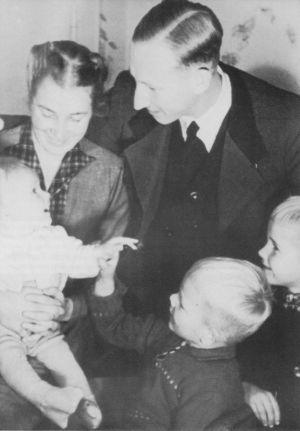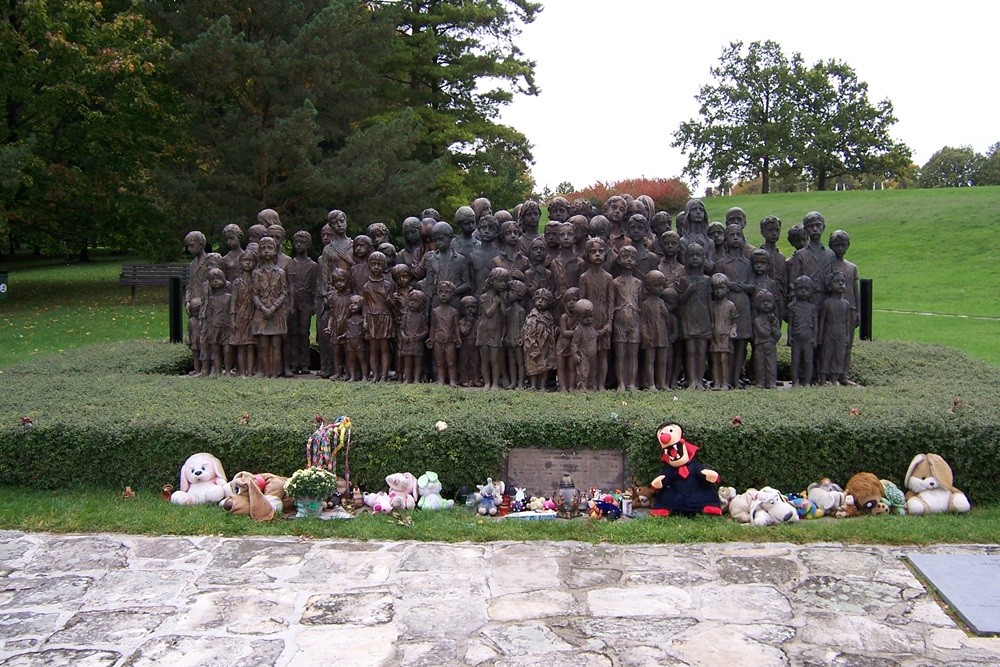Introduction
Reinhard Heydrich rose from leader of an intelligence agency, of which he was the only employee at first, to the second most powerful man within the Nazi terror machine. Joseph Goebbels called him: "The most radical and most successful fighter against enemies of the state." During the war he stood at the helm of the Reichssicherheitshauptamt (R.S.H.A. or Head office of state security) in which the security and police services he was in charge of, were united.
Heydrich has become especially notorious for his close involvement in the realisation of the Holocaust. Because he had succumbed to his injuries after an attempt in June 1942, he did not witness the mass deportations to the various extermination camps but his role in the previous period was extremely important. After the Kristallnacht, he saw to it that the Jewish question was dealt with in increasingly radical measure. During the war, Heydrich was the one to dispatch the Einsatzgruppen to the Soviet Union with orders to execute Jews. He worked towards the so called Endlösung (Final solution) that was discussed at the Wannsee conference in January 1942 with representatives of the ministeries invited by him.
Due to his Arian appearance, his radical commitment, his willpower and his urge to achieve things, Heydrich was the role model of the Nationalsocialist. He was a workaholic, combining his work for the SS with sports, a career as a fighterpilot and ultimately with the post of Reichsprotektor of Bohemen und Moravien (State protector of Bohemia and Moravia). This article is about the person who combined his zest for work with an immense urge for destruction.
Definitielijst
- Endlösung
- Euphemistic term for the final solution the Nazis had in store for the “Jewish problem”. Eventually the Endlösung would get the form of annihilating the entire Jewish people in extermination camps.
- Holocaust
- Term for the destruction of European Jewry by the Nazis. Holokauston is the Greek term for a completely burnt sacrifice.
- Jews
- Middle Eastern people with own religion that lived in Palestine. They distinguished themselves by their strong monotheism and the strict observance of the Law and tradition. During World War 2 the Jewish people were ruthlessly persecuted and annihilated by the German Nazis. . An estimated 6,000,000 Jews were exterminated.
- Nazi
- Abbreviation of a national socialist.
- Soviet Union
- Soviet Russia, alternative name for the USSR.
- Wannsee conference
- Conference at the Wannsee on 20 January 1942. The Nazi’s made final agreements about the extermination of Jews in Europe, the Final Solution (Ëndlösung).
Images
Childhood years
Reinhard Tristan Eugen was born March 7th, 1904 in Halle on the river Saale near Leipzig. His father, Bruno Heydrich was the founder/director of the conservatory at Halle. He played various instruments, he sang in operas and composed music for piano, the choir and the opera Amen. Reinhard’s mother, Elisabeth Heydrich Kranz, a strict Catholic, taught piano at the conservatory of her husband. The name of their son shows the musical interest of the couple. Reinhard was the name of the main person in Bruno Heydrich’s opera Amen, Tristan was derived from the opera Tristan und Isolde by Richard Wagner and Eugen was in honor of Elisabeth’s father, Georg Eugen Kranz, professor of music and Hofrat.
Reinhard was the second child in the family. His sister Maria was born in 1901 and his brother, Siegfried Heinz in 1905. When Reinhard was just six months old, he contracted encephalitis. As his life was in danger, his parents had him baptised ahead of time but their son recuperated. It is impossible to say whether this illness has affected his mental development. It is well known however that he was no easy child. He was pig-headed, unmanageable and hot-tempered. Owing to his difficult character, he was a lone wolf at a young age and he was bullied by other children his age. His traits of character partly matched those of his stern and aloof mother. "You could not really reach her," a friend of the familiy remembers Elisabeth Heydrich. "She lacked feminine and motherly warmth towards young people. She always made a very lofty impression. She possessed a certain amount of arrogance which Reinhard inherited."
Bruno Heydrich did not care overmuch about the upbringing of his children. He was too busy with his successful music institute. Reinhard looked up at his father but never emulated him. He played the violin well but preferred lighter material. Nor did he have a singing voice like his father. During his entire life, he had a high-pitched voice which combined with a bleaty laugh earned him the nickname the goat. Reinhard was succesful in sports. From the moment he entered the Reform-Realgymnasium in Halle in the spring of 1914 he was active in swimming, running, playing football, horseback riding and fencing. He particularly excelled in fencing. He remained an active fencer, even at the peak of his ultimate career within the SS; in December 1941 he finished as best German in the national championships. As a sportsman, but in everything really, he wanted to be the best. As a child he probably wanted to protect himself from the bullying of his contempories by achieving more than others. This compulsive urge to prove himself was to characterise him for the rest of his life.
Heydrich’s political moulding also had its roots in his youth. The Heydrich family was nationalistic and inclined towards the Emperor. Military life appealed to Reinhard very much and the defeat of Germany after the First World War was a huge desillusiuon to him. The prosperous life of his family came to a sudden end. His father’s conservatory drew less and less students and in the winter of 1916-1917, the family even faced hunger for the first time. Like many contempories they believed in the dagger legend and blamed Jews and Communists for the defeat and all their misery.
In the years following the war, political contrasts in Germany were big and rightist as well as leftist radical movements attempted to seize power. Halle was also ravaged by political chaos. When the city was captured by Communist rebels a few days after the capitulation, Heydrich joined a rightist radical Freikorps although he really was still too young. When the Communists had been defeated, he became a member of the civil guard in Halle. During a second revolt in Halle by the Communists, Heydrich served in the Technische Nothilfe, an emergency service set up by the Department of Internal Affairs which had to see to it that electricity, gas and water continued to flow or would be repaired. By his experiences in revolts, his membership of extreme nationalistic movements such as the Völkische Schutz- und Trutzbund (People’s protection union) and advocates of the dagger legend within the Freikorps, Heydrich evolved into a radical follower of the extreme nationalist politics in which racial ideology was an important theme.
Definitielijst
- capitulation
- Agreement between fighting parties concerning the surrender of a country or an army.
- First World War
- Took place from 1914 till 1918 and is also named The Great War. The conflict started because of increased nationalism, militarism and neo-colonialism in Europe. Two alliances battled one another during the 4-year war, which after a dynamic start, resulted into static trench warfare. The belligerents were the Triple Alliance (consisting of Great-Britain, France, and Russia; later enlarged by Italy and the USA, amongst others) on the one hand and the Central Powers (consisting of Germany, Austria-Hungary, Bulgaria and the Ottoman empire) on the other hand. The war was characterized by the huge number of casualties and the use of many new weapons (flamethrowers, aircraft, poison gas, tanks). The war ended in 1918 when Germany and its allies surrendered unconditionally.
- Freikorps
- German paramilitary units established directly after the Great War by former front soldiers. These groups were often named after their commander. Freikorps formed the basis of the eventual SA or Sturmabteilung.
- ideology
- A collection of principles and ideas of a certain system.
- Jews
- Middle Eastern people with own religion that lived in Palestine. They distinguished themselves by their strong monotheism and the strict observance of the Law and tradition. During World War 2 the Jewish people were ruthlessly persecuted and annihilated by the German Nazis. . An estimated 6,000,000 Jews were exterminated.
Images
Naval career
After Heydrich had graduated from the Reform-Realgymnasium with excellent marks he enlisted in the navy on March 30th, 1922 in order to fullfill his dream: to become an admiral. He was posted to Besatzung 22 (Crew). The first six months he underwent training aboard the battle wagon Brandenburg. Subsequently, he spent three months aboard the schooling vessel Niobe and served aboard the cruiser Berlin from July 1923 to March 1924, ending his cadet training. On April 1, 1924, Heydrich was promoted to Fähnrich (non commmissioned officer) and attended the Naval Academy Mürwick near Flensburg for his training as sea officer.
During his training, Heydrich also remained a loner and other crewmembers considered him weird. A crewmember of Heydrich remarked: "Vanity, complacency, coquetry, weak-heartedness and hypersensitivity were conspicuous traits of his character. He soon became an easy target for bullying for all his comrades. And he always reacted the wrong way." Despite the bullying, Heydrich stood his ground. Whenever he felt despondent, he retired to the foredeck with his violin. Aboard the cruiser Berlin, Heydrich’s violin playing drew the attention of Korvettenkapitän (Lieutenant commander) Wilhelm Canaris, the future chief of the German Military Intelligence Service, the Abwehr. Heydrich was regularly invited by Canaris for musical performances with him and his wife at their home in Kiel. Politically speaking, both naval men were on the same wavelength. During their meetings they discussed subjects like the reasons for the German defeat in World War One and the future of Germany. Heydrich was impressed by his contact with this experienced officer. This enabled him to set himself apart from the other crewmembers.
On October 1, 1926, Heydrich was promoted to Leutnant zur See. After he had taken a course for technical officers in the communication department in the first quarter of 1927, he served as second radio officer until October 1928. Subsequently he was promoted to Oberleutnant zur See, the highest rank he would reach in the Reichsmarine. Until he left the navy he served in the communication department on the naval base in Kiel on the Baltic Sea.
Early December, at a dance for rowers, he met 19 year old Lina von Osten. Three days later he proposed to her and they got engaged on December 18. He sent the announcement of his engagement without any explanation also to a girl he had dated often. She considered herself Heydrich’s fiancée. Her father, an influential person on the staff of the navy complained to Admiral Raeder about the disloyal officer. Heydrich was subpoenaed by a Court of Honor. Because he presented himself very complacently and showed no remorse, he was discharged from the navy on April 30, 1931 for his spineless and unworthy behaviour. Nevertheless, he received good marks on his departure. "All his superiors comsider H. a conscientious and loyal officer with a real sense of duty who diligently fullfilled any task alloted to him," his service record read. "Open and of military stature towards his superiors, adored by his comrades. He always treated subordinates well and just."
After the war, much speculation has been going on about the assumption that his discharge would have had anything to do with his rightist radical leanings. This seems improbable however because this certainy would have been exploited by Nazi propaganda. The Nazi press has always kept silent about this. Also much guessing has been going on after the war about the identity of the girl and her father who lodged complaints about Heydrich’s alleged disloyalty. There are many theories, this man would have been a naval construction official, the manager of a shipyard or a high ranking official of the arsenal in Hamburg but irrefutable proof showing the true identity is lacking, partly because the minutes of the session of the Court of Honor have never been found.
Definitielijst
- Abwehr
- Term used for the German military intelligence unit during the WW1 and WW2. From 1935 onwards under command of Admiral Wilhelm Canaris. The organisation often came into conflict with other secret services such as the SD and the Gestapo. During World War 2 under Canaris frequently a source for conspiracies against the Nazi regime until in 1943 a major conspiracy by a number of prominent members of the Abwehr was discovered and the Abwehr was placed under command of Himmler. After the assassination attempt on Hitler in 1944, Canaris was discharged and the Abwehr was dissolved. The conspirators and Canaris were prosecuted and in 1945 they were executed atc oncentration camp Flossenburg.
- cruiser
- A fast warship with 8,000 – 15,000 ton displacement, capable to perform multiple tasks such as reconnaissance, anti-aircraft defence and convoy protection.
- Nazi
- Abbreviation of a national socialist.
- propaganda
- Often misleading information used to gain support among supporters or to gain support. Often used to accomplish ideas and political goals.
Images
First career moves in the SS
After his dishonorable dischrge from the navy, Reinhard Heydrich returned to his parents in Halle, dejected and almost without income. His dream, carving out a career in the navy, had been destroyed forever by his conduct. His parents had problems of their own; his father had suffered a stroke and his mother had to earn a living for her husband, her daughter, her unemployed son in law and her other son and his wife. In order to help her eldest son to find a job, she turned to his godmother, Elise von Eberstein. Her son, Karl Freiherr von Eberstein was Sturmführer in the Schutzstaffel (SS), at that time a small branch of the Sturmabteilung (SA). As a member of the staff of SA leader Ernst Röhm he knew that SS leader Heinrich Himmler was looking for someone who could establish an intelligence agency within the SS. Heydrich knew about the N.S.D.A.P. only from the stories of his fiancée who was a member of this party from her 18th birthday. The rough nature of the SA did not appeal to him but he did like an elite organisation like the SS. On June 1, 1931 he became a member of the Nazi party in Hamburg and two weeks later, on June 14th, he traveled to Himmler’s chickenfarm in Waldtrudering for a job interview.
Heydrich’s eligibility for the function of chief of a yet to be established intelligence service really was some sort of a misunderstanding because he had been a communication officer in the navy, not an intelligence officer. This did not bother Himmler though; at their first meeting he was immediately impressed by Heydrich’s Nordic looks which he described as "tall, blond with correct, sharp and good-natured eyes." The SS leader ordered Heydrich to draft a plan how he imagined an intelligence service within the N.S.D.A.P. to look like. The draft pleased him and he appointed Heydrich chief of the yet to be established intelligence service. On July 14, Heydrich joined the SS in the rank of SS-Untersturmführer. Before he began building his intelligence network, he participated in streets brawls against Communists, earning the nickname of the "blond beast of Dovenburg."
On August 10, Heydrich was promoted to SS-Sturmführer. He moved into a room in the Braune Haus (brown house), the party HQ in Munich and started to set up his intelligence service, giving it the abbreviation Ic after the military spy services. He copied much from the larger and powerful foreign intelligence services, in particular the British Secret Intelliegence Service. Emulating the British, he let himself be called C and even signed his correspondence with this character. Initially, Heydrich’s means were very limited; he had to share his room and his typewriter with other employees and he received so little financial support he could hardly buy enough office utensils. Also he had to make out with unpaid volunteers for the time being. Gradually, Heydrich constructed a network of informers all over the country, albeit with limited means but with a great organisational talent. He gathered all information on system cards about members as well as opponents of the party, in particular information he could use in the future against the individual concerned.
Initially, Heydrich’s main task consisted of tracking down hostile spies such as from the police and the Communist party. On August 26, at a meeting of high ranking SS officers, he warned them that the party had been heavily infiltrated with spies from the police and competing parties that attempted to infict damage on the N.S.D.A.P. with all means possible. He managed for instance to demask party comrade Horninger, whom Hitler had earmarked before as leader of the intelligence service, as an informer of the head office of the Munich police. Himmler praised Heydrich’s efforts. "He had an infallible feeling for people," he praised the chief of his intelligence department. "He foresaw really uncannily the route friend and foe would take." The SS leader decided that, as from September 4, each SS-Abschnitt (district) and each SS-Standarte (regiment) was to establish its own intellingence service that was to report to Heydrich. On December 1, 1939, Heydrich rose yet another step in the hierarchy when he was promoted to SS-Hauptsturmführer.
On December 26, 1931, Heydrich married his Lina. The ceremony was all decked out Nazi style; a swastika of fir branches was suspended over the altar, outside the church the couple walked past a Nazi guard of honor that brought the Hitler salute and on leaving the church, the Horst Wessel song was played on the organ. The day before his wedding, Heydrich was promoted to SS-Sturmbannführer. Meanwhile, he had his own office in the Türkenstrasse 23 since the fall but in 1932 he and his wife moved into a villa, Zuccalistrasse 4 in Munich where he also established his headquarters that now consisited of seven paid employees. On July 29, 1932, Heydrich was promoted to SS-Standartenführer. Between April and June, his intelligence service was temporarily renamed Presse und Informationsdienst (P.I.D. or press and information servce) following the ban on the SA and the SS. Later on the organisation would be called Sicherheitsdienst (SD or Security Service).
Early June 1932, Heydrich was confronted with the rumor that he was of partly Jewish descent. This was not for the first time, because during his career in the Reichsmarine and possibly even before he had already been bothered with it. The origin of this rumor was that three years after the death of her husband, his father’s mother had married Gustav Robert Süss whose name seemd to indicate Jewish ancestry, although there was no question about it in this case. In an encyclopedia of music from 1916 the name of his father was incorrectly noted as Heydrich, Bruno (in fact Süss). Rudolf Jordan, Gauleiter of Halle-Merseburg, wrote a letter to Gregor Strasser, chief of the N.S.D.A.P. organisation in which he pointed to this encyclopedia. Strasser subsequently ordered party genealogist Achim Gercke to investigate. Gercke concluded that:"Heydrich is of German ancestry and is free of tainted or Jewish blood." According to Heydrich biographer Maro R. Dederich, in the attached genealogical list certain data were conspicuously missing, such as the date of birth of Heydrich’s mother and grandfather. It is peculiar that such essential data were missing while at the same time, Himmler demanded "proof of Arianism," going back to the year 1648 from his major associates.
Notwithstanding the rumors about his Jewish ancestry that were declared untrue by the party, Heydrich privately contacted a genealogist who arrived at the same conclusion. Although the rumor itself was based on incorrect facts, Dederich points to certain uncertainties about Heydrich’s ancestry. In Heydrich personnel file, his greatgrandmother is called Johanne Birnbaum. This does not necessarily indicate Jewish descent but strangely enough, this name does not appear in the family tree of his brother where this greatgrandmother is called Maria Rosine Lichner without any further information. Perhaps this does not mean anything, because if this woman had in fact been Jewish, it would have been more logic that her name would have been adapted in Heydrich’s papers rather than in those of his brother.
It has been argued sometimes that Heydrich’s insecurity about his ancestry had been the reason for his loyalty and obedience to Himmler. His radical anti-Semitism would find its origin here as well. In retrospect, this is hard to prove but in any case, it is very likely that the bullying, the rumors and the insecurity about his ancestry have led to Heydrich increasingly denouncing Jewry, beginnning in his period in the Reichsmarine, in order to prove he had nothing to do with it.
Definitielijst
- Abschnitt
- Description for a district of the Sturmabteilung (SA) or the Schutzstaffel (SS).
- brown house
- Society house of the national-socialist movement.
- Gauleiter
- Leader and representative of the NSDAP of a Gau.
- Nazi
- Abbreviation of a national socialist.
- regiment
- Part of a division. A division divided into a number of regiments. In the army traditionally the name of the major organised unit of one type of weapon.
- Schutzstaffel (SS)
- The Schutzstaffel commanded by Heinrich Himmler was a very powerful organisation within the Third Reich. The original goal of the SS was to protect Adolf Hitler and other Nazi’s but soon the SS was deployed for several military, security and police tasks. The SS guarded inter alia the concentration camps and manned the Einzatzgruppen. The armed branch of the SS was the Waffen-SS.
- Standarte
- Paramilitary unit, about the size of a regiment, within the Sturmabteilung (SA) and Schutzstaffel (SS).
- Sturmabteilung
- Storm detachment. Semi-military section of the NSDAP. Founded in 1922 to secure meetings and leaders of the NSDAP. Their increasing power was stopped during “The night of the long knives”, 29 and 30 June 1934.
- swastika
- Equilateral cross, symbol of Nazi-Germany.
Images
The Nazis in power
Adolf Hitler’s appointment as Reichskanzler in January 1933 initially had little effect on Heydrich’s career. At the time, the SS being part of the SA still occupied a subordinate position within the Nazi hierarchy. An important promotion of Heydrich took place in March 1933 when the Nazis seized power in Bavaria. Himmler became the new chief of police in Munich. He appointed Heydrich chief of the political department, the Bayerische Politische Polizei (Baypopo or Bavarian political police). To this pair, Bavaria became the testing ground for the development for their instrument of terror. In order to secure the position of power of the Nazi party, they arrested Communists and other political opponents. On March 22 , Himmler opened the first concentration camp in Dachau where political opponents were imprisoned without any previous trial. A day before, Heydrich was promoted to SS-Oberführer and a few months later, on November 9, to SS-Brigadeführer.
Himmler and Heydrich were not satisfied with their power in Bavaria because it was their intention to merge all scattered police forces in the various federal states into one large, central police force. They succeeded in this very rapidly because in the fall of 1933, Himmler gradually managed to gain power over the secret police in almost all federal states. For the moment however, Himmler did not succeed in taking over authority over the political police in Berlin, the Geheime Staatspolizei (Gestapo or Secret state police) headed by Hermann Göring. This changed on April 20, 1934 when Göring named Himmler Inspektor der Polizei (Inspector of police) and he in turn gave the operational direction of this secret police force to Heydrich. Göring’s reasoning behind this gesture was that he could use a pact with the SS to his advantage in order to eliminate his competitor Ernst Röhm and his SA.
Heydrich was in his element constructing this plot against the SA leadership. The false rumors and fabricated evidence distributed by Heydrich’s Sicherheitsdienst ultimately even convinced Hitler that the SA was preparing a coup. In the night of June 30 - July 1 that entered the history books as the Night of the Long Knives and in the two days that followed, numerous SA leaders including Röhm and old opponents of the party were arrested by the SS and executed. Heydrich appeared not to have been bothered at all by the fact that Röhm was a personal friend and the godfather of his first son.
After the SA had been eliminated, the SS was declared an independent organisation on July 20. On June 9, it was laid down officially that apart from the Sicherheitsdienst des Reichsführers-SS no other intelligence or counter espionnage agencies could exist. Heydrich was promoted to SS-Gruppenführer. As the person responsible for the Gestapo and the SD he was, at the age of 30, the second most powerful man within the SS after Himmler. He re-organised the secret police forces of the various federal states and directed them from Gestapo HQ on the Prinz Albrechtstrasse in Berlin. He put the former Bavarian police officer Heinrich Müller in charge. Numerous employees were replaced by SS men. In the SD, he mainly employed young academics, public officials and businessmen so he could transform his intelligence service into the elite leadership of the SS.
Already before the war, harshness and mercilessness, the policy of occupation and the extermination of the Jews characterised Heydrich’s strategy. "In order to preserve our people we must be tough towards our opponents," he wrote in a pamphlet in 1935, "even taking the risk that we may physically hurt the individual opponent and that we may be branded as violent savages by a number of well meaning people." The same year he talked with a representative of the Red Cross, Swiss Carl Jacob Burckhardt who investigated what happened in the concentration camps. "In foreign countries, we are considered bloodhounds, aren’t we?" Heydrich asked him. "It is almost too hard for individuals but we must be tough as granite, otherwise the work of the Führer wiil be lost. Over time they will be grateful to us for whatever we have taken upon us."
On June 17, 1936, Himmler was named chief of the German police. Shortly after, Heydrich was apppointed chief of the newly established Sicherheitspolizei, a merger between the Gestapo and the Kriminalpolizei. Heydrich, only 33 years of age, now commanded a force of at least 50.000 men. About the only thing that prevented Heydrich’s power from becoming larger than that of his boss was that others than Heydrich were in charge of other important agencies within the SS such as the Ordnungspolizei and the management of the concentration camps. The function of Höhere SS und Polizeführer, a function created by Himmler in 1937 also prevented Heydrich from achieving a monopoly over the police and security agencies. Despite all competition, Heydrich remained Himmler’s closest associate. The way both men needed each other is pointedly described by German resistance fighter Hans Bernd Gisevius who has known them both: "Reinhard Heydrich is nothing without Himmler and Heinrich Himmler is everything with Heydrich." Göring described the relationship between the two men in his own ironic way: "Himmler hat ein Gewissen, das ist Heydrich (Himmler does have a conscience, it is Heydrich."
Heydrich and Himmler were no friends and in various spheres their exact opposites. Himmler, dreaming of Germanic history, was no sportsman, had a weak health and the appearance of a schoolmaster. Heydrich on the other hand was a sportsman, very fit, had both feet firmly on the ground and cut an imposing figure. They found each other in their mutual assertiveness and in particular their craving for destruction. The foundation of the extermination policy during the war was laid simultaneously with their efforts to expand their power, if necessary at the cost of others.
While the SS, prior to the seizure of power, mainly occupied itself with protecting the party against internal and external enemies, Himmler and Heydrich focused on all sorts of enemies of the state in the meantime, including in particular the Jews. Despite his mother being a strict Catholic and his father a member of a Free Mason Lodge, Heydrich recognised much evil in this religion and philosophy as well. "In reality they don’t fight fairly for preservation of religious and cultural values (these are not at all at stake) but they continue their old and bitter struggle for secular dominance in Germany," he said about the Catholic faith. In his opinion, Free Masons were "the instrument of Jewish revenge." Should the Free Masons gain the upper hand in their struggle against Nationalsocialism, they would cause "orgies of cruelty", which would make "the sternness of Adolf Hitler appear very moderate indeed by comparison."
Not only was the professional relation between Himmler and Heydrich never disturbed by mutual conflicts, Heydrich rarely had problems with other Nazi leaders either. In general, most of them stood in awe of him, probably because he gathered information in his archives he could use against them. He sometimes used unconventional methods like the luxurious brothel Salon Kitty in Berlin where on his orders, prostitues were to pump their customers for information while their conversation was being recorded with small microphones. Visitors included numerous important persons such as Josef Dietrich , Joachim von Ribbentrop and the Italian Minister of Foreign Affairs, Count Galeazzo Ciano. The brothel did not yield much information though because the women found it difficult to filch important information from their customers.
Although Heydrich did not have continuous conflicts with his colleagues, as did many other Nazi leaders, he had no friends either. True personal contact was alien to him. "He did not want friends," his wife stated after the war. "He was of the opinion that he should not make friends." Even the marriage to his wife was not always as it should have been and the sex hungry Heydrich had his associates frequently look for sex partners so he could satisfy his needs.
Definitielijst
- concentration camp
- Closed camp where people are being held captive that are considered to be anti- social, enemies of the state, criminal or unwanted individuals. These groups mostly do not get a fair trial or are condemned to doing time in a camp.
- Führer
- German word for leader. During his reign of power Adolf Hitler was Führer of Nazi Germany.
- Gestapo
- “Geheime Staatspolizei”. Secret state police, the secret police in the Third Reich.
- Jews
- Middle Eastern people with own religion that lived in Palestine. They distinguished themselves by their strong monotheism and the strict observance of the Law and tradition. During World War 2 the Jewish people were ruthlessly persecuted and annihilated by the German Nazis. . An estimated 6,000,000 Jews were exterminated.
- Nazi
- Abbreviation of a national socialist.
- Night of the Long Knives
- Night of 30 June to 1 July 1933 during which Hitler killed many of the demanding leaders of the SA, including Ernst Röhm.
- resistance
- Resistance against the enemy. Often also with armed resources.
- strategy
- Art of warfare, the way in which war should be conducted in general.
Images
Holocaust
Reinhard Heydrich and his intelligence apparatus played an important role in the merger of Austria and Germany in March 1938. He sent so called Einsatzgruppen into the country to gather important data and arrest political opponents. At break neck speed, Austria was also subjected to the suppression of his Gestapo and his Sicherheitsdienst. Hitler honored Heydrich for his contribution to the Anschluss. He made the same contribution to the annexation of Czechoslovakia a year later. Previously, he had also played a special role in an event that is often considered the beginning of the Holocaust, namely the Kristallnacht of November 9 and 10 1938. That night, Jews in Germany and Austria fell victim to a pogrom; their shops, homes and synagogues were ransacked and set on fire, many of them were mishandled and dozens were murdered.
Minister of Propaganda Joseph Goebbels was the initiator of the pogrom that was carried out by the SA and other fanatical Nazis. The SS and the German police played a significant role in the background; they had to see to it that the evening progressed in an orderly fashion. In a newsflash about the Kristallnacht Heydrich distributed over all Gestapo and SD offices, he made it clear, apart from other things that "synagogues must only be set on fire when there is no danger of fire spreading to adjacent buildings" and that "Jewish shops and homes may be destroyed but not ransacked." Furthermore, he gave orders to arrest "as many Jews - in particular the wealthy - as can be locked up in existing cells." On November 12 he made up the count at a meeting in Hermann Görings Ministry of Aviation. "All told, 101 synagogues have been destroyed by fire, 76 have been torn down and 7.500 shops have been destroyed," he reported to the participants of this meeting, including the chairman of the Four Year Plan Hermann Göring, Minister of Propaganda Joseph Goebbels and Minister of the Interior Wilhelm Frick.
Heydrich made use of the Kristallnacht to expand his authority concerning the Jewish question. He proposed to establish a central agency for the emigration of Jews which had already been realised in Austria. This agency, headed by his associate Adolf Eichmann had already expelled 50.000 Jews from the country, according to him. He further advocated to have the Jews wear an insignia in order to make them identifiable. That was introduced only as late as 1941 however but on January 24, 1939, Heydrich did receive an order from Göring to establish an emigration office in Germany. Towards the end of the year, 78.000 German and Austrian Jews and 38.000 Czechs had been expelled.
The outbreak of war meant a new step on the road towards the Holocaust. The war began on September 1, 1939 when German troops invaded Poland. In order to justify the attack; directed by Heydrich, Polish raids in the German border region were simulated including the raid on the radiostation at Gleiwitz (Statement Naujocks). During the invasion of Poland, Einsatzgruppen were again sent into the country. Their task was even more radical than at the time of the annexation of Austria and Czechoslovakia and this time consisted of "eliminating all anti-German and anti-State elements behind the frontline by means of counterespionage, arresting politically unreliable persons and securing important counterespionage material." Arresting or executing aristocrats, the intelligentsia, teachers, doctors, priests, landowners and businessmen prevented them from forming a new administrative level and effectively resisting the occupation of their country. The region of Poland occupied by the Germans, was inhabited by over two million Jews. Following the attack on the Soviet Union in 1941, this number increased to over three million. It was considered to deport all Jews in Germany and in annexed as well as in occupied areas to the Nisko region in the General Government, (the part of Poland not annexed by Germany but under German rule) or to the island of Madagascar off the African coast. It soon transpired that both emigration plans caused immense logistic problems and proved impossible to realise.
On September 27, 1939, Heydrich brought the Sicherheitsdienst and the Sicherheitspolizei together in one all encompassing agency, the Reichssicherheitshauptamt (R.S.H.A. or Head Office of State Security). This organisation numbered 60.000 employees and played the most important role in implementing the ‘Endlösung der Judenfrage’ (Final solution of the Jewish question) during the war. In September 1939 Jews were not yet exterminated systematically but the foundations had already been laid. On September 21, 1939, Heydrich gave order that all Jews be housed together in ghettoos "making future measures that much easier" Those future measures still entailed emigration and not genocide, despite the fact that owing to the bad living conditions in the ghettoos, hundreds of Jews perished.
A next step on the road to mass physical extermination of Jews was Operation Barbarossa, the invasion of the Soviet Union that began on June 22, 1941. Again Heydrich’s Einsatzgruppen followed on the heels of the Wehrmacht. Their task was even more destructive than in Poland. "I can only recall Heydrich saying in a speech that in case of war with Russia, all Jews in the East should be shot," Karl Jäger, commander of Einsatzkommando 3 declared after the war. "I also know that one of the Gestapo leaders asked literally: "We must shoot the Jews?" Heydrich answered something like "that goes without saying." Initially, only adult Jews (and also Soviet Kommissars and partizans) were executed by the Einsatzgruppen but Jewish women and children soon followed. Until the extermination camps became operational, an estimated 1.5 million Jews were executed by the Einsatzgruppen.
Both Himmler and Heydrich came to the conclusion that mass executions were a heavy psychic burden on the members of the Einsatzgruppen. Heydrich ordered Arthur Nebe, chief of the Kriminalpolizei and leader of Einsatzgruppe B, to look for a method that was more humane for the perpetrators. Nebe enlisted the help of Dr. Albert Widmann and after various experiments they found a suitable method for murder: an airtight chamber in which victims were gassed by the exhaust fumes of an engine. About the same time, similar experiments were conducted in Auschwitz, not with exhaust gasses but with the pesticide Zyklon B. The first extermination camp was opened on December 7, 1941 in Chelmno. Within 15 months, 150.000 victims were killed, not in gaschambers but in trucks where the loading compartment served as gassing space in which the victims were murdered by carbon monoxide, intially from tanks but later by connecting the exhaust pipe to the trunk (Gas vans). Since November, a second extermination camp was under construction in Belzec.
Even while the Einsatzgruppen were wreaking death and destruction on the eastern front and the extermination camps were being developed, there seems to have been no all encompassing plan yet for the extermination of the European Jews. Presumably, Hitler took this decision as late as December 1941, following the Japanese attack on Pearl Harbor and the declaration of war on the United States by Germany. Meanwhile, since July 31, 1941 Heydrich had been given a free hand by Göring concerning the Jewish question. His order read: "to make all necessary preparations concerning the organisational, factual and material issues for the total solution of the Jewish question within the German sphere of influence in Europe. From this position it was Heydrich who was responsible, a few months later, for the extermination of all German Jews for which Hitler had given the order. He emphasised this at a conference with representatives of the ministerial departments concerned, especially lawyers, in a villa on the Wannsee near Berlin. The subject of this conference was to discuss the practical problems of the organisation of the Endlösung. The fate of 10 million Jews had now been sealed and in the spring of 1942, the systematic mass murder in the extermination camps began.
Definitielijst
- Einsatzgruppen
- "Taskforces of Deployment Squads". Special units composed of various SS and police services under supervision of the Reichssicherheitshauptamt (RSHA). Einsatzgruppen were deployed during the invasion of Poland in 1939 and during operation Barbarossa in 1941. In 1939 these units were ordered to eliminate the Polish intelligentsia. In the Soviet Union they were deployed to execute various political and racial enemies of the Third Reich, like Jews, gypsies and communists. The "Holocaust by bullets" in the Soviet Union was the horrendous first act of the eventual "final solution".
- Endlösung
- Euphemistic term for the final solution the Nazis had in store for the “Jewish problem”. Eventually the Endlösung would get the form of annihilating the entire Jewish people in extermination camps.
- Four Year Plan
- A German economic plan focussing at all sectors of the economy whereby established production goals had to be achieved in four years time.
- Gestapo
- “Geheime Staatspolizei”. Secret state police, the secret police in the Third Reich.
- Holocaust
- Term for the destruction of European Jewry by the Nazis. Holokauston is the Greek term for a completely burnt sacrifice.
- invasion
- Armed incursion.
- Jäger
- Also called fighter plane. Fighter planes can be used for air defence (armed with guns and/or carrying guided missiles) or for tactical purposes (armed with nuclear or conventional bombs or rockets). The aircraft used for tactical purposes are also called fighter- bombers because they are bombers with the speed and manoeuvrability of a fighter. Tactical fighters, equipped with photographic equipment are also used as reconnaissance plane.
- Jews
- Middle Eastern people with own religion that lived in Palestine. They distinguished themselves by their strong monotheism and the strict observance of the Law and tradition. During World War 2 the Jewish people were ruthlessly persecuted and annihilated by the German Nazis. . An estimated 6,000,000 Jews were exterminated.
- Kristallnacht
- The night of 9-10 November 1938. Over 250 German synagogues were destroyed. Tens of thousands of Jews were arrested.
- Propaganda
- Often misleading information used to gain support among supporters or to gain support. Often used to accomplish ideas and political goals.
- raid
- Fast military raid in enemy territory
- Soviet Union
- Soviet Russia, alternative name for the USSR.
- Wehrmacht
- German armed military forces, divided in ground forces, air force and navy.
Images
Aviator
Reinhard Heydrich was no bureaucrat who spent his whole day in office. While he stood at the helm of the R.S.H.A., at the same time he wanted to make an active contribution to the German victory. To that end he was trained by the Luftwaffe in 1939 as a fighterpilot. As an aviator he could achieve things on a personal level and that matched his selfcentered attitude. He was trained on the Messerschmidt Bf 109D at Werneuchen air base near Berlin. During the invasion of Poland he made his maiden flight over enemy territory as an air gunner. Subsequently he was posted to Jagdgeschwader 77 as a fighterpilot. In 1940 he made offensive sorties over Norway and the Netherlands and in 1941 he served in the coastal defence on the German Wattenisland of Wangerooge. A Seagrune was painted on his plane, a Messerschmidt Bf 109E-7.
Heydrich did not excell as a pilot; on the contrary, he had several accidents. On May 31, in Stavanger, Norway, he went upside down in his Messerschmidt because he had accelerated too fast on take off. His plane was severely damaged but he walkd off with no more than an injured arm. On Wangerooge in Juni 1941 he damaged his plane taxiing into the hangar. "Even the best fighterpilot has bad luck sometimes" the Nazi press reported. Himmler was not amused though and forbade Heydrich to fly. The leader of the R.S.H.A. could not be bothered; during Operation Barbarossa he flew a Messerschmidt BF 109 again as part of JG 77. The private plane in which he appeared had probably been given to him by Luftwaffe ace Ernst Udet in exchange for a police number plate enabling him to drive around at night and during enemy bombardments.
During Operation Barbarossa, things went wrong as well; in an attack on July 22 1941 on a bridge over the river Dnjestr, near Jampol in the Ukraine, Heydrich’s plane was hit by Russian anti-aircraft fire. He executed an emergency landing in between the two fronts. Great panic erupted within the leadership of his squadron as it would undoubtedly spell disaster when the mighty SS man would have been killed or captured by the Russians. Heydrich was unhurt however and was taken to safety by his own men who happened to be in the vicinity. Those were members of Sonderkommando 10a of Einsatzgruppe D headed by SS-Hauptsturmführer Otto-Ernst Prast. Again, Nazi propaganda managed to give a positive twist to Heydrich’s crash. "One day, during an action in the east, his Bf 109 was forced down after a furious fight,"the press wrote. "Calling on all powers and determined he managed to land his plane close to the German line. On landing he observed Russian soldiers running away." To Himmnler, it was the last straw; he put a definite end to the Luftwaffe career of his most important associate. In the Luftwaffe, Heydrich had risen to Major and had been awarded the Flugzeugführerabzeichen, the Frontflugspange in silver and the EK 1.
Definitielijst
- invasion
- Armed incursion.
- Luftwaffe
- German air force.
- Nazi
- Abbreviation of a national socialist.
- offensive
- Attack on a smaller or larger scale.
- propaganda
- Often misleading information used to gain support among supporters or to gain support. Often used to accomplish ideas and political goals.
- squadron
- A military unit in the Belgian navy usually six to eight small ships operating together under one command. The smallest military unit in the Dutch air force of about 350 men. In most countries is the designation of a military unit thesize of a company. It is either an independent unit, such as a battery, or part of a bigger Calvary unit. In the air force it is the designation of a unit of aircrafts.
Images
Reichsprotektor
On September 24, at Hitler’s headquarters in East-Prussia, the Wolf’s Lair, Heydrich was appointed deputy State protector of Bohemia and Moravia, the present Czechoslovakia. He replaced the moderate diplomat Konstantin von Neurath who was sent on sick leave. The real reason for Von Neurath’s leave was that he was not up to the problems in the protectorate. The Czech armaments industry, vital for the German war production, was ravaged by sabotage, strikes and a low productivity. Hitler considered Heydrich the person of choice to set things straight. To him this was an important promotion as in the past, his contacts with Hitler had run through Hitler and Göring, he now had direct access to the Führer. At the same time of his promotion, he was named SS-Obergruppenführer, the highesst rank he would attain within the SS.
Shortly after entering office, Heydrich had the Czech Prime Minister, Alois Elias arrested and sentenced to death by a kangaroo court a week later. He was charged with maintaining contact with the Czech government in exile in London at the time Von Neurath had been Reichsprotektor. Execution of his sentence was postponed however so Heydrich had something up his sleeve against the Czech president Emil Hacha. To keep the population quiet, he did remain in function though. After Heydrich had declared a state of emergency, some 400 Czechs were executed in the first weeks after his inauguration. Moreover, more than 4.000 Czechs were arrested and imprisonend by the Gestapo. This included persons who were suspected of resistance or belonging to the opposition. Within two weeks, Czech resistance had been all but broken. "Resistancegroups mostly paralysed, except for a few which will be tracked down because they are able to rejuvenate the paralysed resistance,"Heydrich wrote in a summary of the situation in his protectorate. His iron hard conduct earned him the nickname: the henchman of Prague.
Heydrich’s policy was definitely not only aimed at oppression and terrror because that way he would not succeed in raising industrial and agricultural production. Like a Roman emperor, he provided bread and games for the Czech workers and farmers. He increased food rations and raised wages; he established soup kitchens and improved the social system. In addition, he tried to win over the workers by providing clothing that had become scarce and with vacations in luxurious health resorts. In an important speech, delivered October 2, 1941 to high ranking officials within the protectorate he declared: "One should not anger the Czechs in certain matters […] that they feel obliged to launch the ultimate revolt because they don’t see a way out any more." But: "Our State shall not be scoffed at and is, trite but true, the master of the house." Heydrich’s policy took hold: productivity increased, the Czech arms manufacturers produced weapons for the war once more and there was hardly any question anymore of active resistance against the German occupation. On November 19, 1941, Heydrich, the new Reichsprotektor was symbolically handed the seven keys to the Coronatioin Chamber by the Czech president. Heydrich returned three to him as "symbols of loyalty of Bohemia and Moravia to the Reich."
Despite the measures Heydrich took to keep the peace with the Czechs, his policy was aimed at the standards of the SS. He wanted to realise the ideal SS state in his protectorate, a model for all countries occupied by Nazi Germany. In the short run, mainly the Jews became his victims, apart from political opponents. Soon after he took office, Heydrich sent a number of transports with Jews to Poland where the majority of them would ultimately be murdered. Besides, in 1941 he had the Theresienstadt ghetto established. This ghetto was designated as a model where in addition to the elderly, wealthy and famous Jews would be housed as well in good conditions. This however was a disguise as the living conditons at Theresienstadt were poor and the ghetto was mainly used as a transit camp for the extermination camps in Poland. The majority of the Jews that were interned there did not survive the war.
Heydrich’s long term plans concerned the entire Czech population that had to undergo ethnic cleansing. His plans for the protectorate were: "this area must become German some time and the Czechs ultimately have no business here anymore." Heydrich divided the Czech population into four categories: "We have the following persons here. On the one hand there is the correct race with the correct attitude, then it is simple, we can germanise them. Then there are others, their opposites: they belong to the incorrect race and have the wrong attitude. Those have to leave, there is room enough in the East." He estimated this group at about half the population. They should be housed near the Ice Sea in concentration camps that would be taken over by the Nazis after the expected victory over the Soviet Union. Apart from these groups there was, in his opinion, another intermediate layer of: "people of a bad race but with a correct attitude and people of a correct race with a wrong attitude." He wanted the people in the first group to be "deployed somewhere within the Reich, taking care that they will be unable to reproduce." He wanted the people of a good race and a wrong attitude to be: "housed in a purely German environment to be germanised in order to try and change their attitude or be put against the wall ruthlessly; I cannot house them in the east because they would form a prominent group there that would turn against us."
Berlin was satisfied with Heydrich’s policy in the East. On February 15, 1942, Goebbels wrote in his diary: "the danger to German security in the protectorate from the side of the Czechs, has vanished completely. Heydrich is acting succesfully. He plays a game of cat and mouse with the Czechs and they accept anything he offers them. The Slavs, he emphasises, cannot be educated like you would educate a Germanic people, you have to break them or bend them continuously." In May, Heydrich paid a work visit to France. It was expected that he would be become Reichsprotektor there because he considered his task in Czechoslovakia fullfilled. It would not come to that though because on May 27, 1942, an attempt was made on his life which would cause his death.
Definitielijst
- Führer
- German word for leader. During his reign of power Adolf Hitler was Führer of Nazi Germany.
- ghetto
- Part of a town separated from the outside world to segregate Jewish population. The establishment of ghettos was intended to exclude the Jews from daily life and from the rest of the people. From these ghettos it was also easier to deport the Jews to the concentration and extermination camps. Also known as “Judenviertel” or Jewish quarter.
- Jews
- Middle Eastern people with own religion that lived in Palestine. They distinguished themselves by their strong monotheism and the strict observance of the Law and tradition. During World War 2 the Jewish people were ruthlessly persecuted and annihilated by the German Nazis. . An estimated 6,000,000 Jews were exterminated.
- Nazi
- Abbreviation of a national socialist.
- resistance
- Resistance against the enemy. Often also with armed resources.
- Soviet Union
- Soviet Russia, alternative name for the USSR.
- Theresienstadt
- City in the Czech Republic. Here the Nazis established a model concentration camp.
Images
Assassination attempt
Partly because Heydrich’s radical political plans concerning the Czech population had not remained secret and had been made known widely, resistance in the protectorate against the German occupation had never disappeared altogether. In the spring of 1942, Heydrich’s Sicherheitsdienst recorded an increasing number of acts of sabotage all over Bohemia and Moravia. Heydrich himself knew very well resistance had increased because the day before the attempt he informed journalists: ‘small acts of sabotage, not inflicting much damage but showing an spirit of opposition’ occurred more often. Apparently it made little impression on the Reichsprotektor as he kept moving through Prague in an open car without any bodyguards. When Albert Speer, on a visit to Prague, had pointed out the inherent dangers to him he had answered: "Why would my Czechs shoot at me?" Presumably, he actually thought he was respected by the majority of the population and therefore he was not in danger. Moving around in an armoured car with bodyguards did not fit his overconfident attitude; in his position, his career as a fighterpilot had been rather risky as well.
In London, the Czech government in exile had decided on an attempt on the most powerful man in their homeland. Although resistance there had rekindled a little in the spring of 1942, people were disturbed over the successful pacification policy that strongly undermined their own power. An attempt on Heydrich would provoke the Germans to a harsher and more violent policy, resulting in increasing resistance among the Czech population. An attempt on such a high ranking Nazi would instill fresh courage to all living under German occupation and deal a severe mental blow to the as yet invincible Nazis. The attempt, codenamed Operation Antropoïde was carried out by Josef Gabcik and Jan Kubis who had been dropped on December 29, 1941 near Prague, with help from the British Special Operations Executive (S.O.E.) in London. In the morning of May 27, they were standing somewhere along Heydrich’s customary route from Castle Jungfern-Breschan to his office in Prague.
As Heydrich’s driver decelerated for a hairpin, Gabcik opened fire on the open Mercedes. The rifle jammed and Kubis hurled a grenade that exploded near the right rear wheel. Heydrich was hit by shrapnel but did manage to jump out of the car and open fire on his attackers. He collapsed suddenly. The injured Reichsprotektor was rushed to the nearest hospital where he was operated upon. Heydrich’s spleen was removed, his diaphragm was repaired and the wound was closed. Subsequently his collapsed lung was re-inflated. Horse’s hair from the upholstery had entered the wound, causing an inflamation in the abdominal cavity. Himmler dispatched his personal physician Karl Gebhardt from Berlin in order to halt the inflamation with sulfonamides but to no avail. Heydrich died on June 4.
On the day of the attempt, a state of emergency was declared in the entire protectorate. Police and SS started a manhunt for the perpetrators of the attempt but did not find him that day. Hitler compared Heydrich’s death with a lost battle and called for merciless repression. In revenge, he wanted to have tens of thousands ‘suspected’ Czechs or ‘people having something political up their sleeve’ executed. Himmler managed to decrease the number of immediate executions to a hundred and ordered Heydrich’s replacement, Karl Hermann Frank to arrest another 10.000 persons, including the entire opposing Czech intelligentsia. Hundreds of them were to be executed that very evening. One of the first to be executed was Prime Minister Alois Elias. On May 28, the new Reichsprotektor managed to persuade Hitler that the intended mass reprisals were in violation of Heydrich’s policy and would trigger widespread resistance among the population. The planned execution of 10.000 Czechs was cancelled.
Nevertheless, thousands of Czechs were killed by the Nazis that summer. The largest bloodbath took place in the miner’s village of Lidice where the inhabitants were falsely accused of having provided shelter to the perpetrators of the attempt. On June 9, Hitler gave orders to wipe the village off the face of the earth. The SS executed all 194 male inhabitants, 198 women were deported to Ravensbrück concentration camp (143 survived the war) and 105 children were transported to the ghetto in Lodz (only 17 survived). The village was razed to the ground. On June 24, the village of Lezaky was also targeted as the Gestapo had discovered the transmitter of an agent there. Here a total of 33 people were murdered, including women. Meanwhile, the perpetrators had been betrayed by a comrade and had lost their lives in a firefight in a church in Prague on June 18, 1942. Over 200 persons, including members of the church and others suspected of having helped the agents, were deported to Mauthausen concentration camp where they were killed later.
The last tribute was paid to Heydrich with a grand state funeral full of Nazi symbols. The day after his death, a mourning ceremony was held in Prague. The coffin was displayed in the square of honor and behind it an enormous Iron Cross, flaming dishes and the black and white SS flag at half mast. Tens of thousands, among them many Czechs, paraded past the coffin prior to the ceremony. Afterwards, Heydrich’s remains were taken to Berlin where another mourning ceremony was held in the new Reichskanzlei. Both Hitler and Himmler praised the deceased. "He was one of the best Naionalsocialists," Hitler said, "one of the fiercest defenders of the notion of the Third Reich, one of the most fervent opponents of all enemies of the Reich." Heydrich was posthumously awarded the highest class of the German Order which up to then had only been awarded to Fritz Todt who had died in a plane crash on February 8, 1942. Heydrich was buried in a modest grave on the Invalidenfriedhof in Berlin. At the site of the attempt a monument with his bust was erected. Up to 1945 the monument was permanently guarded by an SS guard of honor.
Definitielijst
- concentration camp
- Closed camp where people are being held captive that are considered to be anti- social, enemies of the state, criminal or unwanted individuals. These groups mostly do not get a fair trial or are condemned to doing time in a camp.
- ghetto
- Part of a town separated from the outside world to segregate Jewish population. The establishment of ghettos was intended to exclude the Jews from daily life and from the rest of the people. From these ghettos it was also easier to deport the Jews to the concentration and extermination camps. Also known as “Judenviertel” or Jewish quarter.
- Iron Cross
- English translation of the German decoration Eisernes Kreuz.
- Lidice
- Village in Czechoslovakia which was demolished in 1942 as a retaliation against the assassination of Reinhard Heydrich . The men were brought before a firing squad while the women were sent to concentration camps.
- Mauthausen
- Place in Austria where the Nazi’s established a concentration camp from 1938 to 1945.
- Nazi
- Abbreviation of a national socialist.
- resistance
- Resistance against the enemy. Often also with armed resources.
Images
Epilogue
Following Reinhardt Heydrich’s death, the R.S.H.A. was headed by Ernst Kaltenbrunner. Under joint direction by him and Himmler the Endlösung, to which Heydrich had made such an important contribution, was continued. The operation aimed at murdering all Jews in the General Government was given the codename Aktion Reinhardt in his honor. In the course of the war, an estimated 5.1 to 6 million Jews had been murdered in Europe by the Nazis and their allies.
Heydrich’s wife Lina ìnitially stayed in Castle Jungfern-Breschan after the death of her husband but she ultimately returned to the island where she was born, Fehmarn to the northeast of Hamburg. Here she ran a pension that was later expanded into a hotel. When this had burned down in 1960, she ran a smaller pub and restaurant. Her second marriage to a Swedish theatremanger and painter lasted from 1965 to 1969. Although a special court in Prague had sentenced her to life imprisonment in 1948, for "having supported the Nazi movement" and "ill treatment of Jews" who had been employed by her, she was never extradited due to the bad relations between East and West during the period of the Cold War. In 1951, she had also been acquitted by a deNazification committee. The confiscation of her real estate on Fehmarn was lifted and in 1952, she and her children received a widow’s and orphan’s allowance, against which protests were raised, although in vain, by the Federal state and the Republic of Germany.
In 1976 Lina Heydrich wrote a biography entitled: "Leben mit einem Kriegsverbrecher" in which she, according to well known German historian Werner Maser: "not only covers up, extenuates imaginatively or rigorously twists many actions of her husband, but obviously and conscentiously hushes up essential matters or simply blames others within the Hitler regime for them." About her husband she wanted to hear nothing negative. "My husband has nothing to do with the Endlösung," she claimed in an interview with the New York Times in 1979. "He has been falsely accused of that. The European Jews have all been taken to the Ural mountains." Two weeks prior to her death, she seems to have seen the light. In a phonecall to a good friend, she stated: "Those things about persecution of Jews and the mass murders, it must be right. But all Nazi leaders have blamed my husband for them because he was already dead."
Lina Heydrich died on August 14th, 1985 at the age of 74 on the island of her birth. The eldest son of the Heydrich’s, Klaus, had been killed in an accident as far back as October 24, 1943. Their other children, Heider, Marte and Silke are still alive today (as of June 21, 2007, the date the original article was published). Since the end of the war, they have had to live with the crimes of their father and his reputation as a Nazi henchman.
Definitielijst
- deNazification
- Post war policy of the allies in Germany to punish Nazi war criminals and to remove known Nazis from positions of power or public service.
- Endlösung
- Euphemistic term for the final solution the Nazis had in store for the “Jewish problem”. Eventually the Endlösung would get the form of annihilating the entire Jewish people in extermination camps.
- Jews
- Middle Eastern people with own religion that lived in Palestine. They distinguished themselves by their strong monotheism and the strict observance of the Law and tradition. During World War 2 the Jewish people were ruthlessly persecuted and annihilated by the German Nazis. . An estimated 6,000,000 Jews were exterminated.
- Nazi
- Abbreviation of a national socialist.
Images
Information
- Article by:
- Kevin Prenger
- Translated by:
- Arnold Palthe
- Published on:
- 19-01-2025
- Feedback?
- Send it!
- 06-'42: Our Diary of the War
- 12-'45: Now It Can Be Told! - How 'Hangman' Heydrich Met His End
- 09-'46: The Truth About Lidice
The War Illustrated
Related sights
Related books
Sources
- DEDERICHS, M.R., Heydrich, Fontaine Uitgevers, 's Graveland, 2007.
- HöHNE, H., Het zwarte korps onder de doodskop, In den Toren, Baarn.
- KERSHAW, I., Hitler - Hoogmoed 1889-1936, Het Spectrum, Utrecht, 2003.
- KERSHAW, I., Hitler - Vergelding 1936-1945, Het Spectrum, Utrecht, 2003.
- KNOPP, G., Hitlers moordenaars, Het Spectrum, Utrecht, 2004.
- READ, A., Discipelen van de duivel, Balans, Amsterdam, 2004.
- SPECTOR, S. & ROZETT, R., Encyclopedie van de Holocaust, Kok, Kampen, 2004.
- WISTRICH, R.S., Who's who in Nazi Germany, Routledge, Londen, 2002.
